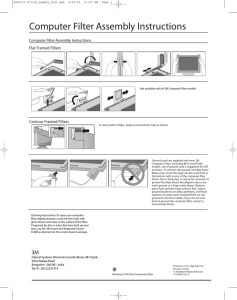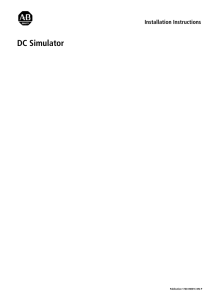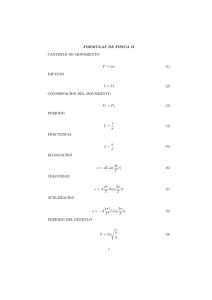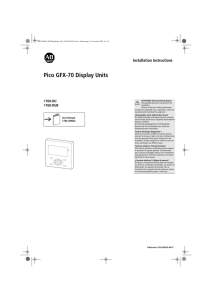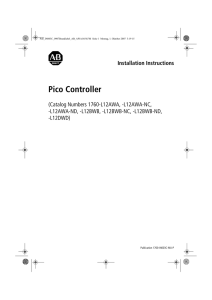striated ground in the venezuelan andes
Anuncio
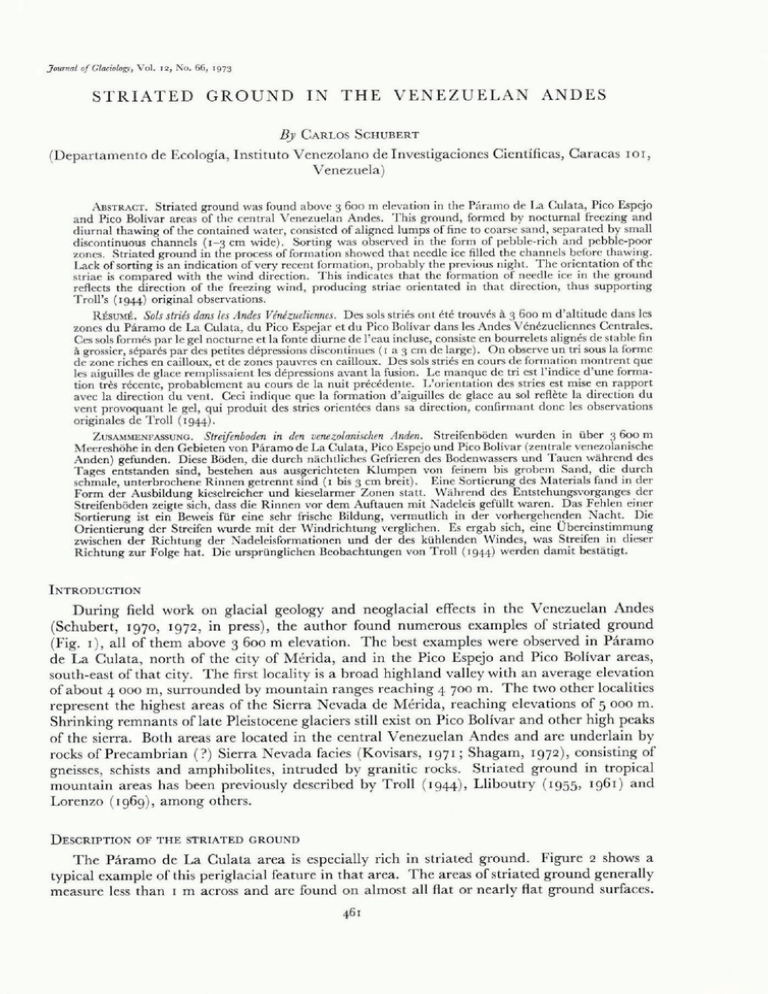
Journal o/Gla ciolog),) V o l. 1 2 ) ~o. 66, 197 3 STRIATED GROUND IN THE VENEZUELAN ANDES By CARLOS S CH UBE R T (D epartamento d e Ecologia, Instituto V enezola no d e Inves tigaciones Cientifica s, Caraca s 10 1, V enezuela) ABSTRACT. Stria ted ground was found a bove 3 600 m eleva tio n in the Pa ra mo de La Cul ata, Pico Espejo a nd Pico Bolivar areas of th e cen tra l Venezuela n And es. This ground , fo rm ed b y noc turn a l freez ing a nd diurnal th awing of th e contai ned wa ter, consisted of a lig ned lu m ps of fi ne to coarse sa nd , sepa ra ted by small discontinuous cha nnels (1- 3 c m wide). Sortin g was obser ved in the form of pe bbl e-ri ch a nd pebble-poor zones. Stria ted ground in th e process of form a tio n showed th a t needl e ice fill ed th e cha nnels before thaw ing. L ack of sorting is a n indication of very rece nt forma tio n, proba bl y th e previous ni gh t. Th e ori enta ti on of th e stri ae is compa red with th e wind direc tio n. T his indi ca tes th a t th e formation of needl e ice in th e g ro und refl ects the directi on of th e freezing wind , producing stri ae ori enta ted in tha t directio n, thus supporting Troll 's ( 1944) original observa tions. R ESIJME . Sols striis dallS les Andes VblCzueliennes. D es sols stries o nt e te trouves a 3 600 m d 'al titude dans les zones du Pa ra mo d e L a C ula ta, du Pico Espej a r et du Pi co Boli var d a ns les And es Ve nezuel iennes Ccntrales. Ces sols form es p a r le gel noc turn e e t la fon te diurne de I'eau incluse, consiste en bourrele ts align es d e sta bl e fi n a g rossier, sep a res par des petites depressions disco ntinues ( I a 3 cm de la rge) . O n o bserve un tri so us la form e d e zone riches en caill oux, et d e zones pauvres e n caillou.x. D es sols stries en cours de forma tion montrent qu e les a iguilles de glace remplissa ient les depressions avan t la fusio n. L e ma nqu e d e tri es t l' indice d 'un e fo rmation tres recente, probablement a u cours de la nuit preceden te. L 'orientation d es tries est mise en ra pport avec la direction du vent. Ceci indique que la form a tio n d' a iguill es de gl ace a u so l reflete la directio n du vent provoqu a nt le gel, qui p roduit d es stries orie ntees dans sa directio n, confirm a nt donc les observations origin ales d e Troll (1944). ZUSAMMENFASSUNG. Streifenboden in den uerlezolanischen Andm. Streifenboden wurden in uber ::l 600 m M eereshohe in d en Gebieten von Pa ramo de L a Cul a ta, Pi co Espejo und Pico Boli var (zentrale venezol a nische Anden) gefunden. Diese Bod en, di e durch nachtlic hes Gefrieren d es Bodenwassers und T a uen wahrend des T ages entstanden sind, bestehen aus ausgerichte ten Klumpen von feinem bis gro bem Sa nd, di e durch schmale, unterbrochen e Rinnen getrennt sind ( I bis 3 cm breit) . Ein e Sorti erung d es M a teria ls fa nd in der F orm d er Ausbildung kieselreicher und ki esela rm er Zonen statl. Wahrend des Entste hungsvorganges der Streifenbode n zeigte sich, dass die Rinnen vor dem Auftau en mit N adeleis gefullt wa ren . Das F ehl en einer Sortierung ist ein Beweis fur eine sehr fri sche Bildung, vermutlich in d er vorhergehe nden N acht. Die Orienti erung d er Streifen wurd e mit der Windrichtung verglic hen. Es erga b sic h, ein e Ubereinstimmung zwischen der Richtung der Nadeleisformati o nen und d er d es kuhlenden Windes, was Streife n in di eser Richtung zur Folge hat. Die ursprunglichen Beobachtungen von Troll ( 1944) werden damit bes ta tig t. I NTRODUCTION During fie ld work on glacial geology and neoglacial effects in the Venezuelan Andes (Schubert, 1970, 1972, in press), the author found numerous examples of striated ground (Fig. I), all of them above 3 600 m elevation. The best examples were observed in Paramo d e La Culata, north of the city of M erida, and in th e Pico Espejo and Pi co Bolivar areas, south-east of that city. Th e first locality is a broad highland valley with an average elevation of about 4 000 m , surrounded by mountain ranges r ea ching 4700 m. Th e two other localities represent the highest areas of the Sierra N evada de M erida, reaching elevations of 5 000 m . Shrinking remnants of late Pleistocene gla ciers still exist on Pico Bolivar and other high peaks of the sierra. Both areas are located in the central Ven ezuelan Andes and are underlain by rocks ofPrecambrian ( ?) Sierra Nevada facies (Kovisars, 1971 ; Shagam, 1972), consisting of gneisses, schists and amphibolites , intruded by granitic rocks. Striated ground in tropical mountain areas has been previously described by Troll ( 1944), L1iboutry ( 1955, 1961 ) and Lorenzo ( 1969), among others. DESCRIPTION OF THE STRIATED GROU ND The Paramo de La Culata area is especially rich in striated ground. Figure 2 hows a typical exampl e of this perigla cial feature in that area. The areas of striated ground generally measure less than 1 m across and are found on almost all flat or nearly flat ground surfaces. 4 61 JO U RNAL OF GLAC I OLOGY y' TIMOTE S ' \ \ ESTADO BARINA S '/ MAR CARIBE ) MERIDA ) / .~ r / o 20 10 F-s;;;J d 30 0;;;4 p8~o~N~______+-____~~__________k_m ______~ Fig. Fig. I . I ndex map . Striated ground in Paramo de La ClIlata (length of hammer is 35 cm ). Note the low degree of sorting into J;ebble-rich and pebble-poor zon~s. 5!. ST RIAT ED GRO UN D I THE VENEZUELAN ANDES Striated ground was observed on the shores of glacial lakes, between large erratic boulders, on top of mOI'ainic deposits a nd , in general, wherever th ere was an open surface of sand y g round . Th e hig h degree of sorting described by Troll (1944, p . 586, fig. 15) in his classic description of patterned ground in tropical mountains was not observed. H owever, in Figure 2 one can distinguish p ebble-rich and pebble-poor zones, which a re evidence of a low degree of sorting. In this area, frozen striated ground was not obser ved but it is evid ent, by comparing Figure 2 (this paper) with fi gures 13, 15 and 21 of Troll ( 1944) and with figure 2 of Lorenzo (1969) , that one is dealing with similar features, i.e. striated ground . I n Pa ramo de La Culata it was found to consist of aligned lumps of fin e to coarse sand , separated by narrow channels abou t 1- 3 cm wide. These cha nnels were not continuous, generally measuring no more than 10- 20 cm in length , but they were parallel to each other. This is probably a reflection of the parallelism of th e bands of needle ice which filled them (Troll , 1944, fig . 14). Tabl e I shows the scant climatic da ta from areas adjacent to Pa ramo d e La Culata. Only two stations (Valle Grande a nd Pa ramo d e La Culata) are located within the Rio Mucujun valley, whose upper part is Paramo de La Culata. The difference in rainfall between this vall ey and that of the Rio Chama (in the higher part of which a ll of the other stations are located ) is evid ent. Rainfall in the Rio Mucujun valley is rough ly double that of the R io TABLE I. R AINFALL DATA (MONTHLY AVERAGES IN mm ) AT LOCALITIES NEAR PARA~W DE LA CuLATA (DI VISIO N DE H IDRO"ETEOROLOGiA, DIRECC ION DE OBRAS HIDRAU LI CAS, MI NISTERIO DE OBRAS P UBLICAS, VENEZUELA) lv/ay J U1le Jan F eb Mar Apr Va lle G rande 59·8 3g·7 57. 0 275. 1 258. 1 105.6 (C.2 500 m ) ( lg6 1- 70) P ara m o de L a Culata 35·7 22·5 44·5 180· 3 162.2 101.5 (c.3 000 m) ( 1961 - 70) (4 11 8 m ) ( 1953- 70 ) Ocl }\ov D ec Y ear 75·7 10 9.3 118.0 173·4 129.0 34·7 I 186.9 87.8 68 ·3 66.1 64. 2 71.3 4·3 13-4 66 ·7 8g .2 g l. 1 77-5 8.6 17·g 6g.g 10 7. 2 130 .6 143·4 109·7 68. 1 10 3-4 124-4 12 7.7 7. 8 17·4 Pico El Ag uil a Sej)l g2.0 8.6 ( l g42- 70 ) Allg 71.0 6. 1 13.2 Muc u chies 5. 6 (3000 m ) ( 1953- 70) San R afael d e Muc u c hfes 6·5 (3 140 m ) ( 1949- 70 ) P a ram o d e l'vluc u c hi es 8·5 (4 11 8 m) J uly 10 7. 2 143. 8 154·3 243 ·4 139· 2 70 .6 1 65 2.0 97·9 78 .0 34·3 77-7 71.9 80·5 80 ·3 83-4 86 ·5 9·9 575·9 3 1.6 8 ·5 63 0 .5 38 ·9 18 .2 81 3.8 54.6 16·3 795·9 C hama vall ey. Table II shows the tem peratures of the last two stations of the Teleferi co d e M erida (a funi cular which conn ects the city of M erida ( 1 497 m ), with Pi co Espejo (4 765 m )) . The Loma R ed onda station (4065 m ) represents the elevation of Pa ramo de L a Cu lata and it is assu m ed that the temperatures are comparable. Tote that in a lmost all months of the year the minimum absolute temperature is below 0° C . Figure 3 shows th e average diurnal variation in the air temperature at L oma R ed onda. Th ese conditions coincid e with those described by Troll (1944, p . 59 1-92 ) for the formation of striated ground : dail y freezing and thawing. The higher atmosph e6 c humidi ty (and consequ ent hig her ground humidity) in the Rio Mucujun valley probably accoun ts for the higher frequency of occurrence of striated ground in its higher parts (as compared with adjacen t areas) . In the vicinity of Pi co E spejo (Fig. I), whose eleva tion reaches 4765 m , striated ground in the process of formation was found . On 12 D ecember 197 1, approximately at 8 a.m., the author observed striae in small patches of sandy ground among outcrops of gneiss and schi t, whi ch form the crest of the Sierra Nevada de M erida . A large part of th e summit was covered by frost and snow covered th e flanks. Figure 4a shows striated ground whose needle ice, w hich fi ll ed the channels between striae, h a d a lready mel ted , produ cing a feature similar to that in Figure 2. Figure 4b, however, shows som e channels which still contain needle ice (especially on the left, just below the small snow patch) . No sorting was observed in this last example ; the ston es and sand are mixed . On the other hand , some orting can b e observed in Figure 4a. JOURNAL OF GLACIOLOGY This probably indicates that the striated ground of Figure 4b is younger than that of Figure 4 a , possibly originating the night before. Sorting is the result of a daily repetition of the freezing and thawing process, while the formation of striae cou ld probably be accomplished overnight. Further evidence for this was found during the latter part of February 1973, in Paramo Mucumposito, just north of Paramo de La Culata (Fig. I ) . Here, an easily accessible locality of striated ground is located at an elevation of 4100 m . At 10 a.m. on 27 February, there were several surfaces of striated ground with rows of needle ice orientated parallel to the prevailing TABLE n . SOME CLIMATIC DATA (MONTHLY AVERAGES) AT THE LAST TWO STATIONS OF THE TELEFERI CO DE M ERlDA 1970- 71 (I NFORME CLlMATOLOGICO, SERVICIO DE METEOROLOGiA, FUERZA AEREA VENEZOLANA) July 1.4 6.8 - 1·9 182 Feb 3.0 9·9 0.1 38 Aug 1.3 6.0 - 2·5 197 Mar 2·3 8.8 - 0 .8 25 Sept 1.4 5. 0 - 2.0 12 7 Jan 0.0 8.0 - 4·4 27 July - 1·9 6.0 - 3. 2 12 9 Feb - 0.2 8 ·7 - 5·4 10 Aug - 1.7 2-4 - 4. 0 17 1 Mar - 0.1 6.8 - 4·7 22 Sept - 1.7 3·7 - 5.0 148 Loma R ed07zda (4065 m) Average temperature (CC ) Maximum absolute temperature (C C ) Minimum absolute temperature (CC ) Total rainfall (mm) Jan 2.6 9·7 3. 6 21 Average temperature (cC) Maximum absolute temperature (C C ) Minimum absolu te tempera ture (C C) Total rainfall (mm) Pico Espejo (4765 m ) Average temperature (C C ) Max im u m absolute temperature (CC ) Minimum absolute temperature (c C) Total rainfall (mm) Average lemperature (CC ) Maximum absolute temperature (C C ) Minim u m absolute temperatu re (C C ) Total rainfall (mm) Apr 3. 8 7·7 0·4 107 Qct 2.0 5. 8 - 1.0 202 Apr - 0.1 8·9 - 4. 6 23 Qct 0.8 3 ·7 - 10.8 178 May 4. 2 9. 1 0 ·9 23 1 Nov 2.0 6.0 - 1·3 96 June 2.6 7·5 - 1.0 157 D ec 1.6 6-4 - 1.6 115 Y ear 2-4 9·7 - 2·5 1 49 8 May - 0 .6 4·5 - 3.0 113 Nov 0.6 6·3 - 2·7 105 June - 1.1 5. 8 - 6.0 13 0 D ec 0.2 7. 1 - 3 ·5 80 rear - 0.6 7. 1 - 10.8 I 135 6 6 5 4 U 3 ~ w 2 Cl: ::J f- « Cl: I 0~ 0 -- / / J ,- .... « -- ..... " "- I -3 0 - -- .......... 3 '\ I 0 " ..... ,,/ 6 4 2 / - 2 '-- ..... ~ '-- , I -I 5 \ I ..... Cl: .... I w w ~ 12 18 ----24 I 2 3 HOURS OF THE DAY - - LOMA REDONDA(4065m) - - - PI CO ESPEJO(4765m) Fig. 3. Daily average variation in the air temperature ( 1970- 71) in the last two stations oflhe Teliferico de Mirida ( from a reporl by Servicio de Meleorologia, Fuerzas Aireas Venezolanas ). ST RIAT E D GRO UN D IN THE VENE Z UE L AN A N D ES (a) (b) Fig. 4. (a) S triated grDll/ld in the vicinity of Pico E spejo (4 765 m ). L ength of pencil is £4 cm. (b) Striated ground with channels filled w ith needle ice,. in the vicinity of Pico Espejo. L <nglh of pencil is £4 cm . JOURNAL OF GLACIOLOGY wind direction (305°) . The ice needles were 4- 5 cm long. In one instance, where the needle ice was produced within pebbly ground, a very clear sorting was observed, the pebbles lying on top of the ice needles, and the sand and silt und erneath, filling the interstices or forming the base for the needles. At 3 p.m. of the same day, the locality was revisited and all orientation, striation and sorting had disappeared due to melting of the ice. On the next day, 28 February, at 9 a.m., the locality was again visited and striation parallel to the wind direction had formed again, similar to that of the previous morning. These data are partially in agreement with the observations of Troll (1944), Corte (1963) and Philberth (1964), who estimated that at least a few days or weeks are necessary for an effective sorting of material to take place by freezing and thawing. This sorting eventually produces the large-scale striae and polygons studied by those authors. Table II and Figure 3 show the climatic data for Pi co Espejo. The daily freezing and thawing of the ground is evident; the minimum absolute temperatures are well below 0° C, while the maximum absolute temperatures are well above 0° C. Therefore, this zone has the optimum conditions for the formation of striated ground. / ~-----4-----=~-------r------~90° E 50 .% - - - 20 MEASUREMENTS. PARAMO DE LA CULATA (8 DEC.1971) , IN % PER 5° INTERVAL (BETW EEN 290 AND 310°) <:0--3 MEASUREMENTS, PICO ESPE JO(12 DEC . 1971) . . - - 2 MEASUREMENTS, PICO BOLl VA R AREA (26 FEB. 1972) Eo- PREDOMINANT WIND DIRECTIONS <i1- WIND DIRECTION AND VELOCITY, 8 DEC . 1971 '*--WIND DIRE CTION AND VELOCITY, 12 DEC . 1971 «l<l--WIND DIRECTION AND VELOCITY. 26 FEB . 1972 Fig. 5. Orientation oJ striae in ground in the Pdramo de La ClILata, Pico Espejo and Pico Bolivar areas; and wind directions at Pico Espejo (measured at the Observatorio MeteoroLogico] de Radoactividad AmbientaL "ALejandro de HumboLdt"). STRIATED GRO UN D IN THE VENEZUELAN ANDES ORIE NTATION OF THE STRIATED GROUND The orientations of the striae in the ground were measured in all of the examples observed and they are plotted in Figure 5. Measurements in the different localities are separated because they were made on different dates. In P aramo d e La Culata, where most of the measurements were mad e on 8 D ecember 197 I , the striae were orientated b etween 290° and 3 10°, although most were b etween 306° and 3 10°. In the Pico Espejo area, on 12 D ecember 1971 the striae were orientated between 300° and 3 10° ; and in the Pi co Bolivar area (front of Timoncito Glacier ; Schubert, in press), on 26 F ebruary 1972 they were orientated between 280° and 285 °. Wind directions on the dates mentioned above are shown in Figure 5. These represent the wind orientations at the approximate times of striae-orientation measurements. The predominant average wind directions at the Pico Espejo sta tion are from the south-east and north-east, with a strong component from the south (personal communication from 'vV . A. Goldbrunner, 4 April 1972 ). A comparison between the orientations of the striae and the wind directions shows a fair correlation. Only the data from th e Pico Bolivar area differ significantly and could be due to their location within a small cirque-like feature. Th e other measurements were made in open a reas, where the wind was no t affected by topographic features. The Pico Espejo station is located on the crest of the Sierra Nevada d e l\IIerida and it registers the winds which pass above it. Th e striae in that locality were in the same situation. These data support Troll's (1944, p . 585) observation that th e origin of striated ground and the orientation of the striae are related to the wind direction . An additional supporting observation was made early in the morning of27 February 1972. On the floor of the Pi co Espejo station, ice needles were d eposited with their long axes parallel to the wind direction (from the south-eas t) and slightly inclined down-wind. This is probably the way striated ground begins to form. The water contained in the ground forms bands of needle ice which, upon thawing, form the striae in the ground. ACKNOWLEDGEMENTS I wish to thank the Teleferico d e Merida for providing transport and topographic m aps of the Pi co Espejo- Pico Bolivar area . A. 'vV. Goldbrunner (Fuerza Aerea Venezolana, Maracay) and H . Silva (Ministerio de Obras Publicas, Caracas) kindly supplied the weath er data. F. Santamaria and I. R ouse upplied copies of oth erwise unavailable publications on earlier work. Special recognition is du e to Haydee H ernandez and O swaldo Rodriguez (Merida) for their help in the field. A. L . Washburn, E. W agner, E. Medina and J. Pasquali made h elpful suggestions. Finally, I should like to thank Cesar Thielen (Merida) for his help during all phases of my work in Merida. An abstract of this report was presented at the 22nd Annual Convention of the Asociacion Venezolana para el Avance de la Ciencia held in Maracaibo in 1972. MS. received 22 January 1973 and additions 13 A1arch 1973 REFERENCES Corte, A. E. 1963. Particl e sorting by repeated freezing and thawing. Scietlce, Vo!. 142, No. 359 1, p. 499- 501. K ovisars, L. 197 1. Geology of a portion of the north-central Venezuelan A ndes. Geological Society of America. Bulletin, Vo!. 82, No. 11 , p. 3 111 - 37. Lliboutry, L. A. 1955. L'origine des sols stries et polygonaux des Andes de Santiago (Chili ). Comptes R endus Hebdomadaires des Seances de l'Academie des Sciences (Pa ris), Tom. 240, No. 18, p. 1793- 94. Lliboutry, L. A. 1961. Phenomenes cryoniva ux d ans les Andes de Santiago (Chili). Biuletyn Perygladalny, No. 10, P· 20 9- 2 4· JOURNAL OF GLACIOLOGY J. L. '969. Minor periglacial phenomena among the high volcanoes of Mexico. (In Pewe, T. L., ed. The periglacial el!vironment, past and presel!t. Montreal , M cGill- Queen's University Press [and] Arctic Institute Lorenzo, of North America, p. ,6' - 75. ) Philberth, K . ' 964, R echerches sur les sols polygonaux et stries. Biuletyn Peryglacjaltry, No. '3, p. 99- '98. Schubert, C . 1970. Glaciation of the Sierra de Santo Domingo, Venezuelan Andes. QJlateTllaria, Vo!. ' 3, p.225- 46. Schubert, C . '972 . L a te glacial chronology in th e northeastern Venezuelan Andes. InteTllat ional Geological Congress. Twenty-fourth session, Canada, 1972, Section '2, p. 103- 09. Schubert, C. In press. Geomorphology and glacier retreat in the Pico Bolivar area, Sierra Nevada de M erida, V enezuela. Zeitschriftfiir Gletscherkunde llnd Glazialgeologie, Bd . 8. Shagam, R . '972. Geologia de los Andes central es de Venezuela. Venezuela. Ministerio de Minas e Hidrocarburos. Direccion de Geologia. Boletin de Geologia, Publicacion E special No. 5, p. 935- 38. [Abstract.] Troll, C . '944, Struktu rboden, SoliAuktion und Frostklimate d er Erde. Geologische Rlllldschau, Bd. 34, Ht. 7-8, P·545- 6 94·
